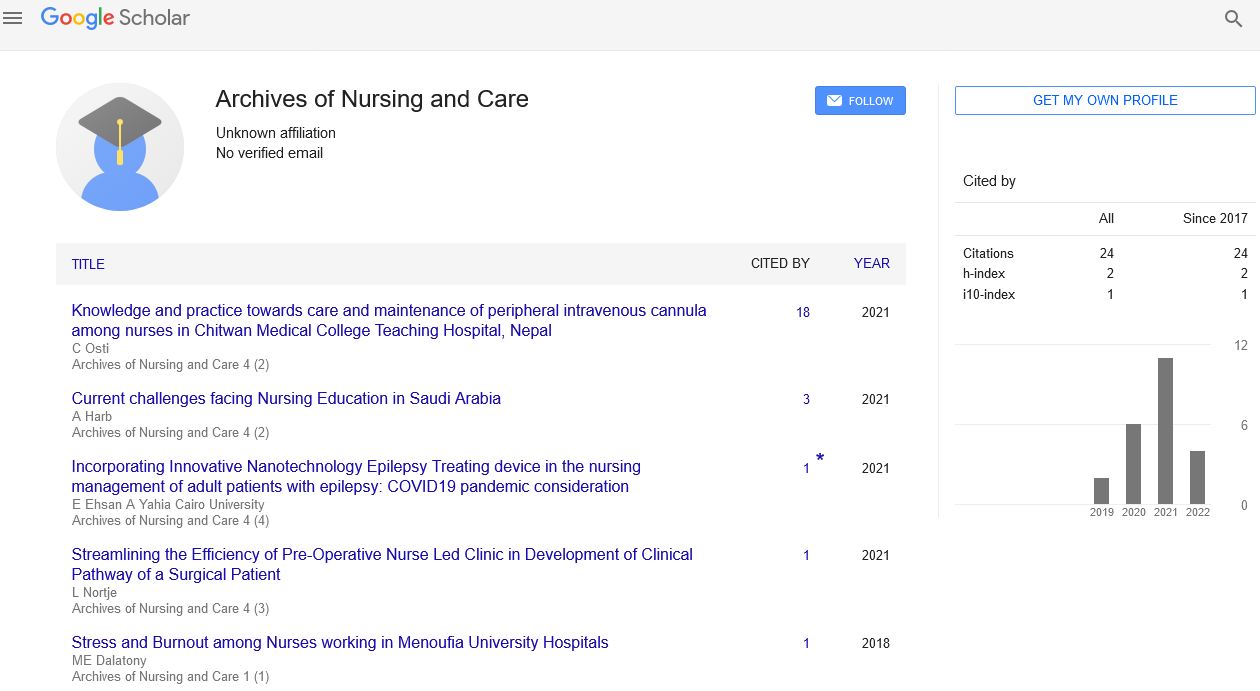Editorial - Archives of Nursing and Care (2023) Volume 6, Issue 3
Impact of COVID-19 pandemic on nurses and its prevalence of Emergency Nurses: Gynecology and Obstetrics Services
Rebbica Joe*
Department of Obstetrics and Gynaecology, El Galaa Maternity Teaching Hospital, Cairo, Egypt
Department of Obstetrics and Gynaecology, El Galaa Maternity Teaching Hospital, Cairo, Egypt
E-mail: Rebjoe578@gmail.eg
Received: 02-June-2023, Manuscript No. OANC-23-96752; Editor assigned: 05-June-2023, PreQC No. OANC-23- 96752 (PQ); Reviewed: 19-June-2023, QC No. OANC-23-96752; Revised: 26-June-2023, Manuscript No. OANC-23- 96752 (R); Published: 30-June-2023; DOI: 10.37532/oanc.2023.6(3).67-69
Abstract
Nursing is considered to be an at-risk profession of burnout due to daily exposure to difficult situations such as death and pain care. In addition, some units such as the intensive care unit (ICU) can be stressful due to high levels of morbidity and mortality and ethical dilemmas. Burnout causes deterioration in quality of care, increasing the risk of mortality in patients due to poor performance and errors in the healthcare environment. The aim of this study was to analyse the levels, prevalence and related factors of burnout in ICU nurses. A systematic review and meta-analysis were carried out in the Medline, Scopus and CINAHL databases. Although burnout levels and the corresponding risk factors have been studied in many nursing services, to date no meta-analytical studies have been undertaken of obstetrics and gynecology units to examine the heterogeneity of burnout in this environment and the variables associated with it. In the present paper, we aim to determine the prevalence, levels, and related factors of burnout syndrome among nurses working in gynecology and obstetrics services. Within the dimensions of burnout, emotional exhaustion had a significant relationship with depression and personality factors. Both sociodemographic factors and working conditions influence the risk of burnout syndrome.
Keywords
Burnout • Nurses • Occupational health • Risk factors • Stress • Intensive care unit
Introduction
Research has shown that occupational responsibilities may compromise workers’ physical and mental health. Among those affected are healthcare personnel, who are particularly vulnerable to disorders, such as anxiety, depression, and burnout syndrome [1].
Burnout occurs when the worker is exposed to a series of chronic stressors, which provoke a deterioration in one or more of the dimensions identified. A commonly-used means of determining the magnitude of burnout is the Maslach Burnout Inventory (MBI) questionnaire, which considers three psychological dimensions of the syndrome: emotional exhaustion, caused initially by the sensation of physical over-exertion, which, in turn, generates emotional weariness and loss of interest in the patient [2]; depersonalization, characterized by detachment, coldness, cynicism, and indifference; low personal accomplishment (PA), i.e., a negative attitude towards the work, low self-esteem, and lack of job satisfaction, which, in turn, provoke a loss of interest and impaired professional performance.
The development of burnout syndrome is influenced by many factors, which can be analyzed to identify possible risk profiles. In this respect, relevant sociodemographic factors include the subject’s age, gender, marital status, and the number of children [3]. Also, the psychological factors, such as personality type, anxiety, stress, or depression, and work-related factors, including a perceived lack of autonomy, the nature of the work environment, salary, and shift work obligation and duration, are important. Among the latter aspects, the specific characteristics of the workplace also exert an important influence. Thus, for nurses, the type of patient, family relationships, and the workload at the hospital unit may all contribute to the appearance of burnout [4].
In attempting to overcome the negative consequences of this syndrome, nurses may neglect their personal and occupational obligations, giving rise to negative attitudes towards their work. Given this consideration, systematic reviews and meta-analyses have examined the prevalence of burnout and its associated risk factors in different hospital units. However, some services, such as gynecology and obstetrics, have received little research attention in this respect [5].
The obstetrics and gynecology service, caring for women’s sexual and reproductive health, is considered a particularly sensitive area. It requires a strong sense of vocation and considerable emotional control, as the nurses here are responsible for providing optimal comprehensive care throughout the female life cycle. Information and emotional support are essential to meet the needs of mothers, during pregnancy, in each stage of childbirth and post-partum [6].
Guided by the framework for interaction and cognitive engagement in connectivist learning, this study constructed the online and offline blended teaching model of OBGYN Nursing, in order to improve students’ autonomous learning, problem-solving skills, and the formation of critical thinking mode [7], achieve the goal of improving students’ comprehensive quality. At the same time, the study experience of nursing undergraduates in blended teaching was discussed by evaluating its implementation effect, and feedback was collected to provide reference for improving the application of blended teaching in nursing education. Hypothesized benefits were increased competency, self-directed learning level, and improved learning outcomes [8]. Given that this is the first study to apply the framework for interaction and cognitive engagement in connectivist learning to nursing course, this study has the ability to identify potential benefits that could be used in future nursing education studies.
Discussion
This study aims to determine the prevalence, level of burnout, and the corresponding related factors in nurses who work in gynecology and obstetrics services, in the view that no previous meta-analyses have been conducted in this respect.
Regarding the relationship between burnout syndrome and the sociodemographic and work-related variables considered, studies have observed high levels of EE among young people, those who are single, and those with less experience because these groups are less self-confident and are subject to greater tension when decisions must be taken; on the other hand, one study reported that D is positively associated with the number of years spent in the profession. Other researchers have concluded that women are more likely than men to experience burnout and that the risk of D is aggravated by women’s greater involvement in care, due to their dual roles, as mother and nurse. Relative youth is also considered a risk factor due to these nurses’ greater uncertainty and low expectations of promotion. Besides, it has been reported that PA is negatively correlated with the number of children in the nurse’s family, due to occupational and personal overload [9]. On the other hand, more recent studies claim that having children is a protective factor, helping nurses live a fuller life.
In terms of organizational characteristics, factors, such as negative sensations regarding the work environment, low salaries, and lack of organization, despite great responsibility, all contribute to reduced job satisfaction and to nurses’ abandoning the profession. Also, falling staff numbers and the reorganization of services, due to low birth rates in developed countries, increase EE and reduce PA. The lack of resources, concerning the demand for care, tends to make health care highly mechanized and medicalized, a situation in which nurses’ competencies are limited, as is their freedom to exercise independent judgment. Furthermore, rotating shifts and the imposition of a 70-hour week increase the risk of burnout, especially in terms of reduced PA, due to work overload and heightened levels of stress. Some authors conclude that a lack of commitment, motivation, or time can be considered alarm signals and that the quality of care may be compromised [10].
Conclusions
Nurses in gynecology and obstetrics services tend to have high levels of EE and D and low levels of PA, but it must be taken into account that due to the influence of occupational variables in each country, these levels may vary.
Some variables that may have a relation with burnout development in gynecological nurses, and that should be analyzed in the future, are being young, relatively inexperienced, single, and/or who have children. Other negative factors in this respect are long working days/ weeks and the need to care for large numbers of patients.
Good leadership and appropriate organization of care duties, providing nurses with sufficient autonomy and appropriate staff numbers, are key factors in preventing the development of burnout.
References
- JanuškeviÄius ZI, StasiÅ«nas AS.Transmission of physiologicalinformationby telephone.Cor Vasa. 5, 152-155 (1963).
- Balogh N, Kerkovits G, Horvath Let al.Cardiac digital image loops and multimedia reports over the internet using DICOM.StudHealthTechnol Inform. 90,148-151(2002).
- Berdusis K.The state of the art: tele-echocardiography and telecardiology.Telemed Today. 7, 25-6(1999).
- Crowe B, Hailey D.Cardiac picture archiving and communication systems and telecardiology – technologies awaiting adoption.J Telemed Telecare. 8, 3-11(2002).
- Yamamoto Y, Tsutsumi Y, Yoshioka Yet al.Site-specific PEGylation of a lysine-deficient TNF-alpha with full bioactivity.Nat Biotechnol.21, 546-552(2003).
- Kaneda Y, Kamada H, Yamamoto Yet al.The use of PVP as a polymeric carrier to improve the plasma half-life of drugs.Biomaterials.25, 3259-3266(2004).
- Tsunoda S, Kamada H, Yamamoto Yet al.Molecular design of polyvinylpyrrolidone-conjugated interleukin-6 for enhancement of in vivo thrombopoietic activity in mice.J Control Release68, 335-341(2000).
- Norouzinia R, Aghabarari M, Kohan Met al.Health promotion behaviors and its correlation withanxietyand some students’demographic factors of Alborz University of Medical Sciences.Journal ofHealthPromotion Management. 2(4), 39- 49(2013).
- Evangelista LS, Shinnick MA.What do we know about adherence and self-care?J Cardiovasc Nurs. 23, 250-257(2008).
- Heberer T.Occurrence, fate, and removal of pharmaceutical residues in the aquatic environment: A review of recent research data.Toxicol Lett.131, 5-17 (2002).
Indexed at,Google Scholar,Crossref
Indexed at,Google Scholar,Crossref
Indexed at,Google Scholar,Crossref
Indexed at,Google Scholar,Crossref
Indexed at,Google Scholar,Crossref

